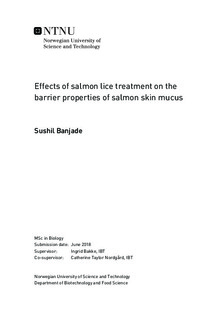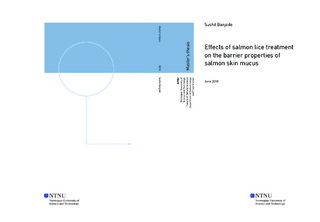| dc.contributor.advisor | Bakke, Ingrid | |
| dc.contributor.advisor | Nordgård, Catherine Taylor | |
| dc.contributor.author | Banjade, Sushil | |
| dc.date.accessioned | 2018-07-31T14:00:44Z | |
| dc.date.available | 2018-07-31T14:00:44Z | |
| dc.date.created | 2018-06-08 | |
| dc.date.issued | 2018 | |
| dc.identifier | ntnudaim:17106 | |
| dc.identifier.uri | http://hdl.handle.net/11250/2507039 | |
| dc.description.abstract | Salmon skin mucus forms a thin physical barrier between the external environment and internal milieu acting as a first line of defence against infection through skin epidermis. In addition, mucus has role in defence mechanism of fish acting as a biological barrier. Reduced function of this barrier can cause threat to the health of fish. The current problem in the salmon farming industry is due to ectoparasitism with sea lice feeding off the flesh and skin of salmon fish. For the efficient control of sea lice, diverse treatment has been tried over the years. Despite the importance of the skin mucosa in the first line defence against environmental pathogens, the effect on barrier properties of fish skin mucus due to lice treatment have yet not been well characterized. The aim of this project was to investigate the effects of treatments applied against salmon lice on the mucus barrier properties.
In this master s thesis, variance in immobilization of 200nm diameter Carboxylate-modified microsphere in two different groups of samples i.e., in untreated samples and freshwater treated samples for sea lice were investigated and compared regarding the mucus thickness. The nanoparticles were placed on the top of salmon skin and the mucus ability to immobilize the given nanoparticles was characterized by using confocal laser scanning microscopy.
We found that there was considerable variability in the mucus and scales structure between two different groups of samples. The variability in mucus and scales was also observed in same fish skin samples and within the same treatment group samples as well. It can be concluded from this study that there was an effect of treatment on salmon skin mucus indicating that freshwater treatment can cause substantial increase in mucus thickness. | |
| dc.language | eng | |
| dc.publisher | NTNU | |
| dc.subject | Biology (MSBIO), Cell- and Molecular Biology | |
| dc.title | Effects of salmon lice treatment on the barrier properties of salmon skin mucus | |
| dc.type | Master thesis | |

